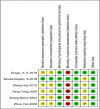Assessment of the effect of vacuum-formed retainers and Hawley retainers on periodontal health: A systematic review and meta-analysis
- PMID: 34242289
- PMCID: PMC8270199
- DOI: 10.1371/journal.pone.0253968
Assessment of the effect of vacuum-formed retainers and Hawley retainers on periodontal health: A systematic review and meta-analysis
Abstract
Background: Recently, increasing attention has been paid to the periodontal health of orthodontic patients in the maintenance stage in clinical practice. The focus of this meta-analysis was to compare the effects of vacuum-formed retainers (VFR) and Hawley retainers (HR) on periodontal health, in order to provide a reference for clinical selection.
Methods: From the establishment of the database until November 2020, a large number of databases were searched to find relevant randomized control trials, including the Cochrane Library databases, Embase, PubMed, Medline via Ovi, Web of Science, Scopus, Grey Literature in Europe, Google Scholar and CNKI. Related literature was manually searched and included in the analysis. Two researchers screened the literature according to relevant criteria. The size of the effect was determined using RevMan5.3 software, and the mean difference and 95% confidence intervals (CI) were used to estimate the results using a random effects model.
Results: This meta-analysis included six randomized controlled trials involving 304 patients. The results of the meta-analysis showed that there was no statistical difference in sulcus probing depth status between the VFR group and the HR group, including at 1, 3, and 6 months. Compared with the VFR group, the HR group showed a lower gingival index at 1 month (mean difference = 0.12, 95%CI: 0.06 to 0.19) and 3 months (mean difference = 0.11, 95%CI: 0.06 to 0.17), while there was no statistically significant difference at 6 months (mean difference = 0.10, 95%CI: -0.07 to 0.27). The plaque index of the HR group also showed a good state at 1 month (mean difference = 0.06, 95%CI: 0.01 to 0.12), 3 months (mean difference = 0.12, 95%CI: 0.08 to 0.16), and 6 months (mean difference = 0.19, 95%CI: 0.09 to 0.29). Subgroup analysis of PLI showed that when all teeth were measured, PLI status was lower in the HR group at 6 months (mean difference = 0.32, 95%CI: 0.18 to 0.46). PLI status was also low for the other teeth group (mean difference = 0.15, 95%CI: 0.08 to 0.22).
Conclusion: Our meta-analysis showed that patients using the Hawley retainer had better periodontal health compared with those using vacuum-formed retainers. However, more research is needed to look at the periodontal health of patients using these two retainers.
Conflict of interest statement
The authors have declared that no competing interests exist.
Figures








References
-
- Cerny R., Cockrell D., and Lloyd D., A survey of patient opinions on fixed vs. removable retainers. J Clin Orthod, 2009. 43(12): p. 784–7. - PubMed
Publication types
MeSH terms
LinkOut - more resources
Full Text Sources
Miscellaneous

